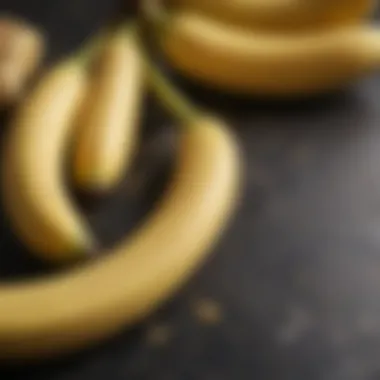Can You Eat Bananas on a Keto Diet?


Intro
Navigating a ketogenic diet can be complex, especially with the presence of fruits like bananas. With their sweet flavor and convenient packaging, bananas are a popular fruit choice. However, their carbohydrate content raises questions about their compatibility with the strict guidelines of a keto diet. This article delves into the nutritional profile of bananas and their carbohydrate content to help you determine if they can fit into your keto lifestyle. By examining typical serving sizes and alternative fruits, we aim to provide a clear perspective on this frequently debated topic.
Nutritional Profile of Bananas
Before discussing their keto feasibility, it is crucial to understand the nutritional value of bananas. A medium-sized banana, which weighs around 118 grams, contains approximately:
- Calories: 105
- Carbohydrates: 27 grams
- Dietary Fiber: 3 grams
- Sugars: 14 grams
- Protein: 1.3 grams
- Fat: 0.3 grams
Due to these values, bananas may not align with a strict keto plan, which typically limits daily carbohydrate intake to about 20-50 grams.
Carbohydrates in a Keto Context
The core principle of the ketogenic diet is to achieve a metabolic state known as ketosis, where the body burns fat for energy instead of carbohydrates. For this to occur, carbohydrate intake must be significantly restricted.
Given that a single banana can contain nearly the entire daily limit of carbohydrates for a person following a strict keto diet, it is essential to choose wisely.
Alternatives to Bananas
If you desire something less carb-heavy, several alternatives provide similar textures or flavors without compromising your keto goals. Here are a few options:
- Berries (e.g., raspberries, strawberries): Low in carbohydrates and high in fiber.
- Avocados: The healthy fat content and low carbohydrate count make them a top choice.
- Coconut: Offers taste versatility and minimal carbs when consumed in moderation.
Practical Advice for Keto Adherence
To effectively maintain a ketogenic lifestyle, consider these strategies:
- Meal Planning: Plan meals in advance to account for carb intake.
- Read Labels: Understand the nutritional content of fruits and other foods.
- Portion Control: If consuming higher-carb fruits, limit serving sizes.
By applying these strategies and considering alternative snacks, individuals following a ketogenic diet can enjoy a diverse menu without compromising their dietary commitments.
Closure
Understanding the Keto Diet
Understanding the ketogenic diet is essential in determining whether bananas can fit into this eating plan. The keto diet alters metabolism by primarily utilizing fats for energy instead of carbohydrates. This shift has a range of implications for various foods, including fruits, which often have higher carb contents. Here, we will examine the fundamental principles of this diet, typical macronutrient ratios, and its advantages.
Definition and Principles
The ketogenic diet is defined by its high fat, moderate protein, and very low carbohydrate approach. The typical definition suggests a macronutrient breakdown of about 70-75% fats, 20-25% protein, and only 5-10% carbohydrates. This diet promotes a process called ketosis, where the body shifts to burning fat for fuel. The goal is to enter and maintain a state of ketosis, which is believed to help in weight loss and improve metabolic health. The principles of keto require strict adherence to these macronutrient ratios, which makes understanding food choices crucial for success, particularly in deciding about foods such as bananas.


Common Macronutrient Ratios
The common macronutrient ratios in a ketogenic diet demonstrate the challenge of incorporating foods that are high in carbohydrates. For individuals on the keto diet, typical macronutrient ratios can look like this:
- Fats: 70-75%
- Proteins: 20-25%
- Carbohydrates: 5-10%
Fats form the cornerstone of meals, providing sustained energy, while proteins support muscle maintenance. Carbohydrates are drastically reduced, often to less than 50 grams per day. This limited carbohydrate intake is what necessitates careful consideration of fruit choices, such as bananas, which contain a significant amount of carbs.
Benefits of the Keto Diet
The ketogenic diet offers various health benefits, appealing to many individuals for different reasons. Some notable advantages include:
- Weight Loss: Many experience significant weight loss due to reduced appetite and increased fat burning.
- Improved Blood Sugar Control: The keto diet may help stabilize blood sugar levels, useful for those with diabetes.
- Enhanced Mental Clarity: Some report better focus and cognitive performance while in ketosis.
- Potential Heart Health Improvements: By impacting triglyceride levels and HDL cholesterol positively, keto may boost cardiovascular health.
These benefits can motivate individuals to adhere to the diet rigorously. However, the compatibility of certain foods, particularly fruits like bananas, with these benefits becomes pertinent. Understanding keto diet fundamentals helps clarify what can effectively be included in meal plans without disrupting ketosis.
"Understanding the keto diet foundation is vital before deciding on including high-carb foods like bananas."
By grasping these overarching principles, readers can better navigate their choices, leading to informed decisions about bananas and other potential dietary additions.
Nutritional Profile of Bananas
Understanding the nutritional profile of bananas is key to determining their place in a ketogenic diet. Bananas are often recognized for their low-fat content and high carbohydrate value. When evaluating their compatibility with keto, it is crucial to focus on their specific carbohydrate content, vitamins, minerals, and the types of sugars they contain. This analysis will help individuals make informed choices about their diet while considering the goal of maintaining ketosis.
Carbohydrate Content
Bananas are known for their relatively high carbohydrate content. A medium-sized banana, roughly 118 grams, contains about 27 grams of carbohydrates. This amount is significant when compared to the daily carbohydrate limit recommended for those on a ketogenic diet, which typically varies from 20 to 50 grams. Thus, consuming a banana could easily consume a large portion of the daily carb limit, potentially hindering the process of achieving ketosis.
It is also important to note how the body processes these carbohydrates. Bananas consist mainly of starches and sugars, which may lead to a rapid rise in blood sugar, impacting insulin levels in the body.
Vitamins and Minerals
Despite their carbohydrate content, bananas provide essential vitamins and minerals that contribute to overall health. They are a good source of vitamin C, vitamin B6, and potassium. Each of these nutrients plays a role in various bodily functions. For example, potassium is important for muscle function and maintaining proper electrolyte balance. Vitamin C offers antioxidant properties, while vitamin B6 is crucial for protein metabolism and brain health.
However, considering a ketogenic diet often emphasizes other nutrient-dense, low-carb vegetables and fruits that can offer similar or greater vitamin and mineral value without the high carbohydrate cost.
Sugar Types in Bananas
Bananas contain primarily two types of sugars: fructose and glucose. The presence of these sugars contributes to the overall carbohydrate load, offering a quick source of energy. However, for someone on a keto diet, this rapidly available energy is counterproductive to achieving ketosis, as the body shifts from using glucose to fat as its primary energy source.
The unique sugar composition of bananas means they can spike blood sugar levels quickly, making them a tricky option for keto dieters.


Opting for lower-sugar fruits may be a beneficial alternative for maintaining a balanced nutrient intake while adhering to the principles of a ketogenic lifestyle.
Bananas and Ketosis
The relationship between bananas and ketosis is a topic that invites considerable scrutiny. Understanding this connection is vital for those committed to maintaining a ketogenic diet while indulging in a fruit that is often seen as off-limits. Ketosis is a metabolic state where the body primarily uses fat for energy instead of carbohydrates. It is crucial to monitor carbohydrate intake to achieve and maintain this state. This section delves into how bananas fit into this metabolic framework, considering their carbohydrate profile and various other factors relevant to keto dieters.
Impact on Blood Sugar Levels
Bananas have a distinct impact on blood sugar levels. Their carbohydrate content, mainly in the form of sugars, can cause spikes in blood glucose. When you eat a banana, the digestive system breaks down these carbohydrates into glucose, which enters the bloodstream. This rapid influx can lead to a quick increase in blood sugar levels. For individuals on a strict ketogenic diet, this can disrupt ketosis, where the goal is to keep blood sugar and insulin levels low. Studies show that maintaining stable blood glucose levels is essential for sustaining ketosis. Therefore, consuming bananas can pose a challenge, particularly in larger quantities.
Glycemic Index of Bananas
The glycemic index (GI) is a valuable metric to consider when discussing foods within a keto framework. Bananas have a moderate glycemic index value, typically ranging from 51 to 60 depending on their ripeness. This means that after consumption, bananas can lead to a moderate rise in blood sugar levels. For those adhering strictly to keto, foods with a higher GI can hinder efforts in weight management and fat burning. It's essential to compare bananas with other fruits, many of which have lower GI scores, making them more compatible with a ketogenic lifestyle.
Risk of Exceeding Carb Limits
One of the most significant concerns regarding bananas in a ketogenic diet is the risk of exceeding daily carbohydrate limits. A medium-sized banana contains about 27 grams of carbohydrates. Given that many ketogenic diets limit daily carbohydrate intake to around 20 to 50 grams, this single fruit can take a substantial portion of the daily allowance. Overconsumption of bananas can lead to unintentional carbohydrate overload, effectively pushing the body out of ketosis. It is crucial to balance fruit intake carefully, ensuring that each choice supports the diet's overall goals.
"Eating bananas while on a keto diet can often feel like walking a tightrope; careful consideration is needed to avoid slipping out of ketosis."
In summary, bananas can pose challenges for those adhering to a ketogenic lifestyle. Understanding their impact on blood sugar, their glycemic index, and the risk of exceeding carbohydrate limits is crucial for making informed dietary choices.
Alternatives to Bananas on Keto
Navigating a ketogenic diet requires a careful selection of foods to ensure that carbohydrate intake remains within the recommended limits. While bananas are nutrient-rich, their high carbohydrate content can make them less suitable for individuals adhering to strict keto guidelines. Therefore, exploring alternatives to bananas becomes essential for maintaining ketosis without compromising nutritional benefits. Below, we will examine options that can replace bananas effectively while still providing sufficient vitamins and minerals.
Low-Carb Fruits
Finding fruits that fit into a low-carb lifestyle is vital for those on a ketogenic diet. Some fruits have significantly lower carbohydrate counts, making them more compatible with keto principles. Here are some worthwhile substitutes:
- Avocados: Known for their healthy fats and fiber, avocados are one of the best low-carb fruits. They contain about 2 grams of net carbs per 100 grams.
- Berries: Strawberries, blackberries, and raspberries are lower in carbs compared to other fruits. For instance, just a small handful of raspberries adds only about 5 grams of net carbs.
- Lemons and Limes: These citrus fruits can be used for flavoring and have negligible carbohydrate content, making them great additions to various keto dishes.
- Watermelon: With a high water content and about 7 grams of net carbs per 100 grams, watermelon can provide a refreshing snack option but should still be consumed in moderation.
These low-carb fruits not only satisfy sweet cravings but also deliver vitamins that are essential for overall health on a ketogenic diet.
Vegetable Options
In addition to fruits, vegetables can also serve as excellent alternatives to bananas. Many non-starchy vegetables are rich in fiber and micronutrients while being low in carbohydrates. Here are some options:
- Leafy Greens: Spinach, kale, and romaine lettuce are all low in carbs and provide ample vitamins A and C. They can form the base of salads or smoothies, aiding in nutrient density without excess carbohydrates.
- Zucchini: This versatile vegetable can be spiralized into noodles or used in various dishes. With just 3 grams of net carbs per 100 grams, zucchini offers a great way to enjoy a variety of meals without carbohydrate overload.
- Bell Peppers: Colorful and crisp, bell peppers are low in calories and carbs. They offer about 6 grams of net carbs per 100 grams, making them a flavorful addition to many dishes.
- Cauliflower: Often used as a rice or potato substitute, cauliflower is low in carbs (about 3 grams of net carbs per 100 grams) and high in fiber, which can help maintain digestive health.
Incorporating a variety of these low-carb fruits and vegetables can help create balanced, nutritious meals. They provide essential nutrients without derailing one's ketosis or exceeding carbohydrate limits.


Ultimately, understanding and utilizing these alternatives is crucial for long-term success on the ketogenic diet.
Practical Tips for Including Bananas
Including bananas in a ketogenic diet requires careful consideration. While bananas are nutrient-rich, their carbohydrate content poses a challenge. It is crucial to manage portion sizes and understand how to complement bananas with low-carb foods. These tips aim to help individuals make informed choices while still enjoying bananas.
Managing Portion Sizes
Portion control is essential when incorporating bananas into a keto lifestyle. A medium banana contains approximately 27 grams of carbohydrates, which can significantly impact daily carbohydrate limits. To manage intake, consider the following strategies:
- Choose Smaller Bananas: Opt for small bananas which have fewer carbohydrates.
- Monitor Frequency: Limit banana consumption to once or twice a week.
- Measure Carefully: Use a food scale to accurately weigh portions and track carb intake.
Being mindful of portions can allow for strategic integration of bananas without derailing your keto plan.
Pairing with Low-Carb Foods
Pairing bananas with low-carb foods can mitigate their carbohydrate impact. Incorporating a banana into a meal or snack alongside low-carb components can provide satiety without overwhelming carbohydrate limits. Here are suggestions for effective pairings:
- Nut Butters: Spread almond or peanut butter on banana slices offers healthy fats and proteins.
- Greek Yogurt: Full-fat Greek yogurt can create a balanced snack. Opt for unsweetened varieties to keep carbs low.
- Chia Seeds: Adding chia seeds to banana can increase fiber and protein content, promoting a fuller feeling.
Summary
Strategic management of portion sizes and thoughtful pairing with low-carb foods can enhance the potential of including bananas in a keto diet. These practical tips help navigate the complexities of carbohydrate intake while allowing enjoyment of this nutritious fruit.
"The key to enjoying bananas on a keto diet lies in moderation and smart food pairing."
Balancing the enjoyment of bananas with the guidelines of a ketogenic diet does not have to be complex. With these strategies, individuals can find ways to include bananas in their meal plans thoughtfully.
Summary of Key Takeaways
The summary section of this article underlines crucial insights regarding the compatibility of bananas with a ketogenic diet. For individuals adhering to keto, understanding these key points can guide dietary choices effectively.
Firstly, the carbohydrate content in bananas is relatively high, which raises concerns for those attempting to maintain ketosis. This is essential knowledge since the standard ketogenic diet restricts carbohydrate intake to about 20 to 50 grams per day. Hence, even a small banana could significantly impact daily carb limits.
Additionally, it is important to recognize the various vitamins and minerals bananas provide. Although they are nutritious, the potential for increased blood sugar levels must be weighed against these benefits.
Final Recommendations
Based on the findings discussed, it is prudent to limit banana consumption while on a keto diet. Opting for smaller portions or selecting very ripe bananas can help in managing overall carbohydrate intake. For those who wish to indulge, pairing bananas with high-fat, low-carb foods may mitigate their effects on blood sugar levels. It can also be beneficial to track daily macro intake to ensure one stays within a suitable range.
For optimal results, consider incorporating low-carb alternatives to bananas, such as berries or avocados, which can provide similar satisfaction without excessive carbohydrates.
Further Reading
To deepen your understanding of the ketogenic diet and its principles, consider exploring the following resources:
- Wikipedia on Ketogenic Diet
- Britannica on Ketogenic Diet
- For community discussions and personal experiences, check out posts on Reddit.
- Follow various ketogenic discussions and updates on platforms like Facebook for ongoing support and information.
"Knowledge is of no value unless you put it into practice."
This quote emphasizes that merely understanding the facts about bananas and the keto diet is not enough. Practical application is the key to making informed dietary choices.







